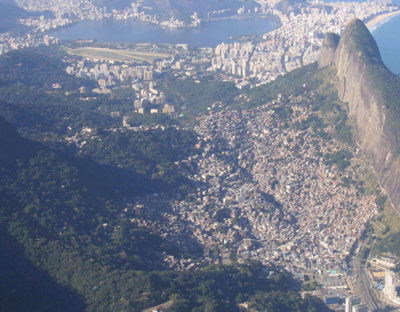| Favelas |
| The cities in the XXI century |

The great cities in the XXI Century “especially in Latin America, but not only there”, show a clear trend of polarization increase (included/excluded from the benefits of urbanity), the entropy (amount of clutter of the spatial urban system), and the lack of cohesion of the urban structure as a whole, going in the direction of increasingly uncontrollable urban nebulas (Sao Paulo, Rio, Mexico City, Caracas, etc.).
In these extensive territories, only a determined parcels of order are manageable (as Sao Paulo showed it a few months ago), specifically in those sectors of the city where the headquarters of the politic, economic, military and police powers, and the neihgborhoods of economically favoured social classes are located.
In this context, the security of the citizen is increasingly threatened.
Nowadays, reality offers a great polarization of ways to deal with this,
following different paths.
Thus, while in some countries they elaborate coordinated alternatives
for short, medium, and long terms, (in reality without success, as the
ministry of the cities has shown), the majority continues acting through
isolated and partial initiatives, reproducing old surpassed approaches.
In this landmark, the constant growth of the “informal” sector is the symptom of slogans like “development”, “regulation through the market”, and “democracy.”
On
which solutions can we work?
In the first place, on those who search for the re-direction of the social
and spatial processes in course, thinking the territory from its productive
logic, articulated with the general development of one side (strategical
processes, macro-interventions, and infrastructural constructions), and
with the local development on the other side (micro-interventions, urban
occupancy).
Which questions do we ask today?
-How
to efficiently use the available (always scarce) resources?
-How to achieve the participation of the citizens?
-How to conceive and put in action strategic plans (long term) that include
actions of exemplar character, capable of generating adhesion from the
beginning? It is to say, how to articulate the “tactic” and
the “strategic” from a vision that considers the productivity
of the territory, the social capital, and the local development, as innate
elements?
-How to drastically change the image of places without any quality? How
to introduce elements of “prestige” in the extended peripheries,
that constituting alternatives to “junk spaces” (thematic
parks, shopping centers, closed condominiums)?
-How to produce connectivity in our broken cities? A few connectivity
strategies, which can be used are:
·
Elaborate new means of articulation with the context pm the border between
formal and informal city; able to function as social anchors;
· Create new accessibilities; physic and symbolic;
· Reinforce the existing centralities and create new attractors
with enough critical mass (dimension, density, and visual presence), creating
conditions of ownership;
· Introducing services and equipment, with spatial and formal quality,
in the peripheries and popular neighborhoods, fighting against the unequal
logics in the offer of services on the territory;
· Looking to establish continuities through the incorporation of
different types of vegetation, modifying the actual relation green mass-
built mass;
· How to contribute for a truce in cities and societies that are
characterized by
exhibitionism of economical power, lack in public services, and an overflow
of violence?
· How to include this enormous quantity of people, introducing,
in the life of candidates to “marginality”, other perspectives?
· “Common denominators”: deserting
of the center, especially at night; existence of areas of impunity; unequal
distribution of the public transportation system; uncontrolled growth
and lack of prestigious equipment in the peripheries; lack in conditions
of urbanity (conviviality spaces), and monotony, that are share by the
rich and poor areas in the peripheries.
“Differentiators”: the scale of the problem
is, first of all, different from country to country (in Rio, Sao Paulo,
and in Mexico City, the informality reaches approximately 30% of the population,
in Caracas, it reaches 60%, and in Buenos Aires 10%), the existence of
informal areas (favelas) in the center of the city characterizes Rio,
and in a much smaller scale, Buenos Aires; the variation of the efficiency
in distribution of the public transportation system (the worse case being
Caracas, and the relatively best, being Buenos Aires and Mexico City).
Jorge Mario Jáuregui